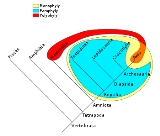
Cladistics
Overview
Clade
A clade is a group consisting of a species and all its descendants. In the terms of biological systematics, a clade is a single "branch" on the "tree of life". The idea that such a "natural group" of organisms should be grouped together and given a taxonomic name is central to biological...
s, which consist of an ancestor organism and all its descendants (and nothing else). For example, birds, dinosaurs, crocodiles, and all descendants (living or extinct) of their most recent common ancestor form a clade. In the terms of biological systematics
Systematics
Biological systematics is the study of the diversification of terrestrial life, both past and present, and the relationships among living things through time. Relationships are visualized as evolutionary trees...
, a clade is a single "branch" on the "tree of life
Tree of life (science)
Charles Darwin proposed that phylogeny, the evolutionary relatedness among species through time, was expressible as a metaphor he termed the Tree of Life...
", a monophyletic group.
Cladistics can be distinguished from other taxonomic systems, such as morphology-based phenetics
Phenetics
In biology, phenetics, also known as taximetrics, is an attempt to classify organisms based on overall similarity, usually in morphology or other observable traits, regardless of their phylogeny or evolutionary relation. It is closely related to numerical taxonomy which is concerned with the use of...
, by its focus on shared derived characters (synapomorphies
Synapomorphy
In cladistics, a synapomorphy or synapomorphic character is a trait that is shared by two or more taxa and their most recent common ancestor, whose ancestor in turn does not possess the trait. A synapomorphy is thus an apomorphy visible in multiple taxa, where the trait in question originates in...
).

